Kalev Jarvik stands on a bald patch of land in the heart of Estonia’s Haanja nature reserve and remembers when he could walk straight from one side of the reserve to the other under a canopy of trees.
Jarvik has lived in the Haanja uplands in the southern county of Voru for more than 10 years. His closeness to the forest has shaped his life as a carpenter and the fortunes of the surrounding villages, with their handicraft traditions – a substitute for farming on the poor arable land. Upcountry, travel literature promotes the region to city dwellers, promising its ancient woodlands as a place to rest and reinvigorate the mind.
But in 2015, the Estonian government allowed what is known as clear-cutting in some parts of the Haanja nature reserve. The practice involves stripping entire areas of mature forest and removing whole tree trunks.
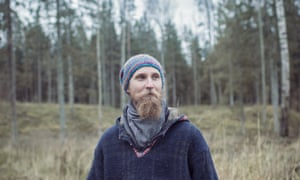
This relaxation of the logging rules came as international demand for Estonian wood soared – not just for furniture or construction, but because of an unlikely culprit: Europe’s renewable energy policies.
“Sometimes I can’t bear to go outside,” Jarvik says, standing by the stumps left on land stripped by the logging company Valga Puu. The firm is a subsidiary of Graanul Invest Group, Europe’s biggest producer of the wood pellets which are burned on an industrial scale as biomass for heat and light in many of Europe’s former coal-fired power stations.
The days Jarvik is spared the sound of harvesters have become rare. “You don’t want to leave home, because the landscape has become so impassable, it leaves you feeling anguished. But still the noise comes.”
Forests cover 2m hectares or more than half of Estonia. Around 380,000 hectares (939,000 acres) of that, including the Haanja nature reserve, fall under the EU’s Natura 2000 network, which is designed to protect Europe’s forests and offer a haven to rare and threatened species. Haanja is home to 29 protected species, including the black stork, the lesser-spotted eagle and the corncrake.
Natura-protected zones are managed under the legally binding provisions of the 1979 EU birds directive and the 1992 habitats directive. But logging is governed by domestic laws, and Estonia permits it as long as it does not damage bogs and other special habitats, or fall within bird mating seasons.
Campaigners say that by allowing intensive clear-cutting in Natura 2000 sites, Estonia is in breach of the habitats directive and undermining the EU’s climate goals.
Siim Kuresoo of the non-profit Estonian Fund for Nature (ELF) doesn’t just blame the Estonian government. He says there is a direct connection between the subsidised growth in the biomass industry encouraged by EU renewable energy policies and the acceleration of unsustainable Baltic tree-felling.
“There is clear evidence that the intensification of logging is at least partly driven by higher demand for biomass for heat and power,” says a report co-authored by Kuresoo for the ELF and the Latvian Ornithological Society. “Given that over half of Estonia’s and Latvia’s wood pellet exports in 2019 went to Denmark, the Netherlands and the UK, ‘green energy’ use in those three countries contributes directly to increased logging in the two Baltic states.”
The Council of Estonian Environmental NGOs (EKO), of which the ELF is a member, has made a complaint to the European commission alleging “systematic” breaches by Estonia of its forest conservation obligations.
***
To investigate the subsidised European pellet trade and its impact on Baltic forests, we uploaded boundary files for Estonia’s Natura 2000 zones to Global Forest Watch, an online platform for monitoring forests, and found that per-hectare tree cover loss (the removal of the tree canopy rather than outright deforestation) in these areas accelerated after 2015. That was when the government adjusted park conservation rules to allow clear-cutting of up to one hectare at a time in some nature reserves.
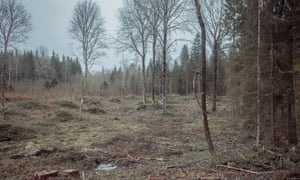
Across Estonia, between 2001 and 2019, Natura 2000 areas lost more than 15,000 hectares (37,000 acres) of forest cover, an area more than twice the size of Manhattan. The last five years account for 80% of that loss. Further alterations to rules in other Estonian national parks are planned.
This acceleration appears to be taking a toll on bird species like the black grouse, woodlark and others. Woodland birds are declining at a rate of 50,000 breeding pairs a year, according to national records.
The clearances are also damaging the ability of Baltic forests to store carbon, and could be undermining climate goals by reducing the chance for Estonia and Latvia to achieve net-zero greenhouse gas emissions.
In a country where the overwhelming majority of peoplesay they regard nature as sacred, logging has led to protests or what the Estonian media calls the “forest war”. Residents of Saku, a small town 16 miles south of Tallinn, successfully fought to save an area of forest that was scheduled to be cut down this year by RMK, the state forest management company, which manages around half of Estonian forests.
“We convert our trees into pellets and sell them to energy plants in your countries,” says Ivar Raig, one of the Saku campaigners. “This is considered to be sustainable, but we suffer.”
****
Sustainability goes to the heart of the European renewable energy debate. The drive to replace coal, one of the world’s biggest sources of carbon emissions, with cleaner sources of power, is a top priority in the fight against climate change globally.
A switch to burning wood in the form of pellets appears to offer a simple and in theory carbon-neutral alternative to coal-fired power stations because trees take up carbon dioxide from the air as they grow. As long as the burned trees are replaced with new plantings, there is no net addition to the stock of carbon in the atmosphere.
However, that process of carbon take-up can take many decades. And in the furnace, burning wood releases more carbon dioxide per unit of energy than burning gas, oil, or even coal. By accelerating carbon dioxide emissions in the short term, burning wood for electricity could be fatal for states’ ability to meet the Paris Agreement goal of keeping global heating to well below 2C by 2050.
Demand for woody biomass or energy from wood as an alternative to coal in power stations took off from 2009, when the first EU renewable energy directive obliged member states to source 20% of energy from renewable sources by 2020 and classified biomass energy as carbon-neutral.
A flaw in the legislation meant that woody biomass was fully categorised as renewable, even if it came not just from wood residues or waste, but from whole trees. This meant that companies could directly harvest forests for pellets – rather than making pellets from the by-products of timber cut for other uses – in the name of sustainable forest management.

As the EU moved in 2018 to double the use of renewable energy by 2030, scientists warned the European Parliament that this loophole in the sustainability criteria of the revised EU legislation would accelerate the climate crisis and devastate mature forests. But against the competing interests of the multibillion euro biomass lobby, it went unamended.
Almost all European countries have recorded an increase in logging for energy. Nearly a quarter of the trees harvested in the EU in 2019 were for energy, up from 17% in 2000.
Biomass, of which wood from forests is the main source, now makes up almost 60% of the EU’s renewable energy supply, more than solar and wind combined, and a vast cross-border industry has emerged to meet this demand.
Taxpayer subsidies are driving much of the growth in this trade. Between 2008 and 2018, subsidies for biomass, of which wood is the main source, among 27 European nations increased by 143%. In the UK, government support for biomass projects is expected to total more than GBP13bn by 2027 – the date at which current subsidy agreements expire, according to the climate thinktank Ember.
***
When Raul Kirjanen founded Graanul Invest in 2003, it was just him and his computer in a small office. By 2005 the company had opened its first factory in Imavere, Estonia, compressing sawdust and the waste wood from other processes into tiny pellets that could be bagged up and shipped overseas for burning in everything from domestic heaters to vast power plants to generate electricity.
Today the European wood pellet trade is booming. Graanul Invest is the second biggest wood pellet maker in the world and Kirjanen is one of the richest people in the Baltics where the Estonian press call him “the pellet king”. In 2019, the company manufactured 2.5m tonnes of pellets, up from 1.8m tonnes the previous year, across its plants in Estonia, Latvia, Lithuania and the US.
Every month tens of thousands of tonnes of wood pellets leave the port of Riga to cross the North Sea on Graanul Invest’s vessel, the MV Imavere. Much of this cargo is bound for the port of Immingham, where it is transported to UK power stations including Drax, which has converted four of its six units from coal to biomass since 2013 and is now the world’s largest biomass burning plant. The UK accounts for more than a third of Graanul’s annual revenue. Denmark, the Netherlands and Italy are also target markets.
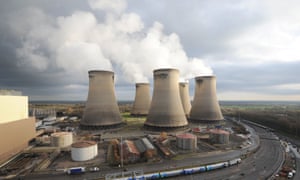
But electricity production from wood pellets would not be financially sustainable without public subsidies: the British government paid Drax the equivalent of EUR2.4m (GBP2.1m) a day in 2019. Drax will have received more than EUR11.2bn (GBP10bn) from the UK government since its conversion to biomass in 2012 until subsidies run out in 2027, researchers from the Ember have calculated.
The UK is now the biggest subsidiser of bioenergy in Europe, spending more than GBP1.9bn in 2019 primarily to pay for burning imported wood at Drax, according to new research by the Natural Resources Defence Council (NRDC) and Cut Carbon Not Forests. Britain is no longer bound by EU renewable energy targets post-Brexit but has set a new target of cutting emissions by 68% by 2030 and is committed to the EU goal of net-zero carbon by 2050.
Other European governments are following suit. In the Netherlands, the government has promised energy companies RWE, Uniper and Onyx (formerly Engie) more than EUR3.5bn in subsidies to use biomass, making the country one of the biggest importers of wood pellets in Europe. Campaigners are anxiously watching Germany, where Onyx Power, a subsidiary of the US hedge fund Riverstone, is examining the possibility of converting coal plants to biomass.
“Biomass only exists at the scale that it does because of subsidies,” says Duncan Brack, associate fellow at the London-based thinktank Chatham House. “We’re effectively paying to increase carbon emissions in the atmosphere, which is an absurd use of public money.”

Brack says that the 2009 EU renewable energy directive triggered a raft of subsidies for renewable power generation. “But since then solar and wind have really crashed in price. Now is the time to stop subsidising biomass.”
“There’s huge infrastructure employing people and spending money, all based on subsidies,” says Michael Norton of the European Academies’ Science Advisory Council (EASAC). “The original simplistic idea of bioenergy from sustainable forestry suddenly blossomed into an industry achieving the opposite of what it was meant to do.”
****
In November 2020 we visited the Haanja nature park to verify the accelerated felling suggested by satellite data. Travelling south through the park, we passed small villages made up of wooden houses, wide black lakes and cows grazing in pastures. Near Vakari village our van took a left, passing wetlands surrounded by birch trees, and turned on to a stretch of road in a clearing. It was as if someone had carefully cut out rectangles of forest. A sign said the plot was owned by Valga Puu.
Since 2016, more than 100 hectares (247 acres) of forest in the Haanja park have been felled on land owned by Graanul Invest Group, a significant increaseon the previous five years, when less than 20 hectares (49.4 acres) was felled, according to Global Forest Watch. We checked their data against our own analysis of high-resolution Google satellite images and corroborated it on the ground.
Graanul Invest collects 84% of its wood by clear-cutting, according to its 2019 sustainability report. “Clear-cutting is the main harvesting method in Estonia that allows us to renew forests the fastest way,” the company told us. “Most trees in Estonia have quite a short lifespan and harvesting and planting a forest sublot as a whole means that all young trees will be at the same age and can start to grow together.”
In practice, the method means leaving mostly stumps in the harvested patch. In the nature reserve, a few trees stand sentinel, part of Graanul Invest’s efforts to maintain biodiversity.
The forest portfolio owned by Graanul Invest and its subsidiaries spans 55,000 hectares (136,000 acres) across Estonia and Latvia and 12% of this is land protected under conservation programmes such as Natura 2000.
Graanul has been able to accelerate tree felling on the protected lands because Estonia’s Nature Conservation Act divides it into three zones: strict nature reserve, conservation zone, and limited management or buffer zone. Human intervention is prohibited in the first two; limited economic activities by landowners, including logging, are allowed in the buffer zones. Clear-cutting in buffer zones must still comply with the EU habitats directive.
Graanul Invest says the adjustment of the rules since 2015 hasn’t changed how much its forest management companies cut down, but makes them “more efficient”. The company also says their forest management companies do not directly harvest wood to be turned into pellets. “The main target is to harvest high-quality logs for sawmills or [the] plywood industry, then to pulp mills. Only material that is not suitable for other industries comes to pellet production,” a spokesperson said.
Official literature from its logging subsidiary Valga Puu tells a different story. “Our goals for 2020 are related to the supply of Graanul Invest plants,” the company says in its latest annual report. We put this to Valga Puu’s chief executive, Andres Olesk. “Not the best wording,” he responded.
But 40% of the wood that Graanul Invest harvests on this land comes from whole trees deemed not straight enough or the right size, for such uses such as furniture or construction. This “low-quality wood”, as it is called in the trade, is crushed and turned into wood pellets.
Harvesting old and poorly managed forests can increase the ability of the forest to hold carbon and improve the habitat for small birds and mammals, according to the European commission. This could be the case in Estonia, where much of the woodland grew naturally 70 years ago on farmland left behind by Estonians who were killed or deported from rural areas during the second world war. “The share of low-quality timber in Estonian forests has always been high due to the fact that during the Soviet era the forests were not managed at all,” Marku Lamp, deputy secretary general of the Estonian ministry of the environment, says. “This has in some ways been an opportunity to sell the low-quality stock.”
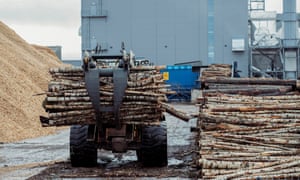
But Almuth Ernsting of climate activist group Biofuelwatch says the term “low-quality wood” is based on economic considerations only: “[It] takes no account of the ecological, climate or cultural value of the trees.”
Robert Matthews, a UK climate scientist whose team carried out some of the research underpinning the revised EU Renewable Energy Directive, describes the idea of low-quality wood as “the sting in the tail”. “What is low-quality wood? It’s almost like a get out of jail free card.”
On paper, Estonia’s forest stock seems to be stable and even slightly increasing, according to Estonia’s 2020 Forest Resources Assessment (FRA). On the ground, we found felled areas replanted with small spruces, which count towards forest area, even though the young trees will take decades to absorb the same amount of carbon as the old felled trees. These “temporarily unstocked or recently regenerated” forests have increased more than 20% since 2010, FRA data says, with serious consequences for the capacity of Estonian land to store carbon. As a result, the Estonian land-use sector, which includes forestry, is expected to switch from being a carbon sink to an emitter of carbon by 2030, according to Estonia’s National Energy and Climate report – the same year by which, under the EU’s updated Renewable Energy Directive, Europe must have increased its energy from renewable sources to 32%.
Graanul Invest replanted 1.5m trees in 2019, according to its annual report. Birch, a deciduous tree, is the dominant species across the 55,000 hectares (136,000 acres) in the company’s portfolio, but Graanul Invest replants 1.7 times more coniferous types such as spruce, a fast-growing species that the company says can “improve the carbon sequestration capability” of forests. Even so, it takes years for these tiny spruces to grow large enough to extract or sequester the carbon that is emitted by cutting them down – a problem known as carbon debt.
It takes decades or even centuries for whole trees, unlike corn or other biomass crops, to regrow, says Massimiliano Patierno, an environmental engineer at the International Institute of Law and Environment. “If we count a period of, say, 40 years, in which the new trees have cancelled the carbon debt, then yes, that biomass can be seen as carbon-neutral,” he says. “But if we consider a very short period of time, it is likely that the carbon debt will not be cancelled.”
Dr Mary Booth at the Partnership for Policy Integrity says that if the wood or forestry residues burned for electricity were instead left to decompose on the soil, they would emit carbon dioxide more gradually. “The accumulated net impact of such emissions likewise speeds warming,” she says.
The latest felling in the Natura 2000 part of the Haanja nature park took place recently in a forest that was 70 years old and home to a number of different species, Siim Kuresoo says.
Experts hold that generally, the more diverse the forest, the greater the variety of animals and plants it can host. Ziga Malek, assistant professor in land use and ecosystem dynamicsat Vrije Universiteit in Amsterdam, says: “The vegetation that was there before protected the soil from being eroded.” Clear-cutting is allowed in Natura 2000 areas as long as it does not conflict with local conservation rules, Malek adds. “In this case it would mean minimum disturbance,” he says. “Which this is not.” Replanted forests can provide climate benefits, he adds, but they cannot fully replace the lost forest ecosystem.
Altering the forest type can also affect the amount of carbon stored in the ground. Mature and closer-to-natural forests sequester more carbon in the long run, due to a healthier ground biomass, Malek says. “Even if the clear-cut area is planted with one fast-growing species, it will not be as effective in terms of carbon sink as the more nature-like forest would in the long term.”
Kirjanen says his company is not doing anything out of the ordinary. In an email, he said that the “awesome” Estonian timber industry is the largest employer in rural areas because it has been able to grow and compete internationally. Almost all Europe’s existing forests are the result of “forest management” of a similar kind. “If we want our forests to be like this in the future, they must be managed,” he said. “Many protected areas in national parks are semi-natural communities, and without maintenance, conservation values often disappear.”
***
There are signs that the EU intends to tighten the rules around what wood can be harvested as renewable energy. An expert group convened by the European commission recently recommended that biomass should be considered sustainable only if it comes from feedstocks listed in an annexe of the renewable energy directive, including bark and sawdust, and “pre-commercial forest thinnings”, apart from sawn logs.
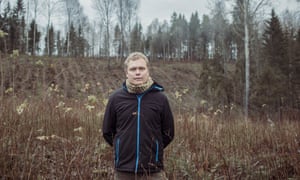
Graanul Invest says that if there is demand for wood as in other fields, it makes sense to use the waste material both from forestry and the wood industry for useful applications – including energy. But scientists and campaigners say we simply don’t have time to cut down trees for energy production if we are going to meet climate goals.
“The urgency has completely changed in the last 15 years,” Michael Norton says. “We don’t have until 2070 – emissions have to come down sooner. Biomass that increases carbon emissions in the next 10 to 30 years is not compatible with climate change policy.”
Back in the Haanja nature park, Kuresoo says it will take many decades for the trees that have been felled to date to grow back to their former size. “This idea of carbon neutrality is a fairy tale,” he says. “Climate change is already happening. We should be planting trees instead of taking them down.”
This article is based on Money to Burn, a cross-border investigative project led by the Dutch public investigative journalism platform Argos and supported by Investigative Journalism for Europe. Additional reporting by Catherine Joie, Piret Reiljan, Paul Toetzke, Sophie Blok, Ties Gijzel, Silvia Nortes and Ben Heubl.
-
This article was amended on 14 January 2021. Drax has converted four of its six units from coal to biomass, not four power plants as an earlier version said.
